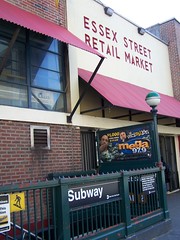Subway entrance at the Essex Street Retail market
When the APA conference was in DC in 2004, I went to a session on Cerda and Barcelona (figuring that was a topic I really didn't know anything about). One of the comments by the presenter was how "surgical" the approach is in Barcelona in terms of incorporating uses within the public space. The example he showed was the entrance to an underground parking garage located below a public square.
Manhattan in NYC has the same approach, because the value of land is so high. Subway entrances were 'surgically' inserted into the street and sidewalk scape in a manner that maximizes the use of space, and minimizes the intrusion.
Compare this subway entrance to a DC subway entrance.
Now, I realize that DC's subways are much deeper below the surface. My understanding this is because the red line had to go below Rock Creek. And, we have, justifiably, requirements for elevators for the disabled, although that doesn't really have to impact the main entryways...
The overuse of land for subway entrances in DC gives a much different feel. I guess the entrances that come closest to a "New York" state of mind are the ones for Gallery Place at 7th and H Streets, 9th and G Streets, and at the Verizon Center, the south entrance for Dupont Circle, and the McPherson Square, Farragut West, and Farragut North stations. Maybe Ballston, Clarendon, Courthouse, and Rosslyn stations as well.




0 Comments:
Post a Comment
<< Home